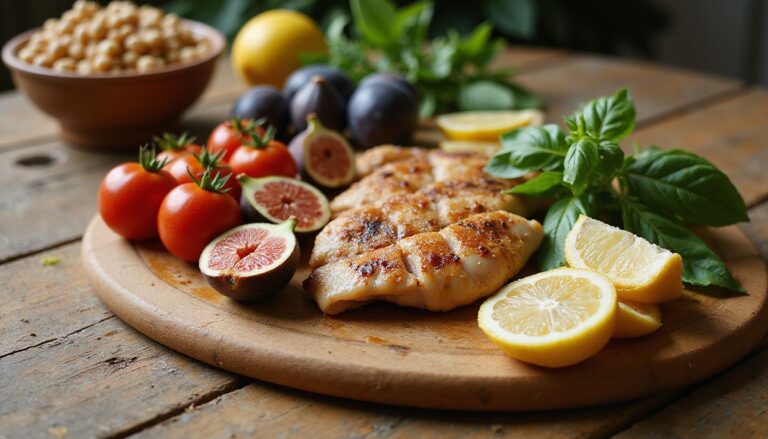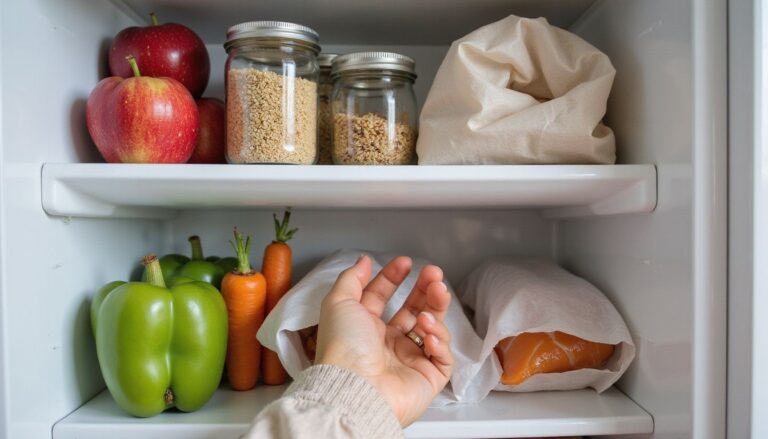Boost Your Health With A Protein Diet: High-Protein Foods To Fuel Your Body
Our Nutrition Assistant AI Suite will transform your body. You will lose fat, get toned, and build muscle. Gain confidence and optimal health.
Finding meals that keep me strong and satisfied can feel hard. A high-protein diet gives me steady energy and helps me stay full, which supports weight management. If you worry about getting enough protein, simple food swaps can make a big difference.
This guide explains what a high-protein diet is, how much protein to eat, the best high-protein foods for every meal, key benefits, and smart tips to get started. I also share quick ways to balance nutrition and avoid common mistakes.
Key Takeaways
- The Recommended Dietary Allowance is 0.8 grams of protein per kilogram of body weight, or 0.36 grams per pound. Many adults meet this with about 50 grams per day for women and 60 grams for men.
- High-protein eating supports muscle growth, increases calorie burn during digestion, improves fullness, and helps maintain bone strength, based on research summaries from the NIH and the Dietary Guidelines for Americans.
- Top protein sources include lean meats, fish like salmon and tuna, eggs, dairy, beans, lentils, tofu, nuts, seeds, and whole grains such as quinoa and farro.
- Very high animal protein may strain kidneys in people with kidney disease and has a higher environmental footprint than most plant proteins.
- Vegetarian and vegan diets can meet protein needs with soy foods, legumes, nuts or seeds, and higher protein whole grains.

What Is a High-Protein Diet?

A high-protein diet is a style of eating that features foods high in protein. I build meals with lean meats, dairy, eggs, legumes, soy, nuts, seeds, and some whole grains. This pattern helps me feel full, supports muscle repair, and can assist with weight loss.
What is the definition and purpose of a high-protein diet?
A high-protein diet prioritizes foods rich in protein, including poultry, fish, eggs, yogurt, cheese, tofu, beans, nuts, seeds, and quinoa. The goal is to meet or exceed the basic daily protein target to support muscle building and repair.
Many diets for weight loss use higher protein to reduce hunger and improve fullness. Some plans also limit refined carbohydrates. That shift can help the body use stored fat for energy. I noticed better gym recovery once I raised my protein at each meal.
Experts suggest spreading protein across the day to keep energy stable and support muscle health. Small amounts at each meal work better for me than one large serving.
How much protein should I eat daily?
Most adults need at least 0.8 grams per kilogram of body weight each day. That equals 0.36 grams per pound. A person who weighs 165 pounds needs about 60 grams of protein daily. The Mayo Clinic Health System lists 50 grams for many women and 60 grams for many men as simple targets.
To estimate your daily protein, multiply your weight in pounds by 0.36. Some people need more, such as athletes, adults over 50, and pregnant women. Many aim for up to 1 gram per kilogram to protect muscle mass. Do not exceed 2 grams per kilogram without medical advice.
Benefits of a High-Protein Diet
Eating enough protein supports muscles, bones, and steady energy. I also find it helps with appetite control during weight management.
How does a high-protein diet support muscle growth and repair?
Protein provides amino acids, which are the building blocks for muscle. After exercise, muscle fibers need these building blocks to repair and grow. Higher protein intake helps me keep or gain muscle, especially as I age.
Older adults often benefit from about 1 gram per kilogram per day to maintain muscle, as noted in the Dietary Guidelines for Americans. I mix animal and plant sources, like chicken, fish, tofu, beans, eggs, and dairy, to cover all needs.
After adding a chicken breast or salmon after workouts, I recovered faster and felt less sore.
Can a high-protein diet help with weight loss and feeling full?
Yes. Protein helps me feel full longer by affecting hormones that control appetite. That makes it easier to reduce calories without feeling deprived. Early weight loss on low-carb, high-protein plans can include water loss, but higher protein also helps prevent weight regain.
Meta-analyses show a small increase in daily calorie burn with higher protein intake. Pairing protein with fiber, like beans or lentils, increases fullness between meals. I rotate lean poultry, fish, tofu, and legumes to keep calories and saturated fat in check.
How does protein regulate blood sugar levels?
Protein slows the digestion of carbohydrates. That reduces sharp spikes in blood sugar after meals. Replacing some refined carbs with protein may improve blood sugar control for people with prediabetes or diabetes.
When I add eggs, chicken, or strained yogurt to breakfast, my energy stays steady and cravings drop. Plant proteins like lentils add both amino acids and fiber, which further helps control blood sugar (USDA research summaries).
What are the benefits of protein for bone health?
Protein supports bone structure. People who meet protein needs tend to have better bone mineral density and a lower fracture risk. Dairy foods combine protein with calcium, which helps build and protect bones.
Tofu, tempeh, and edamame also contribute minerals needed for bone health. After an ankle injury, raising my protein helped my body repair tissue. Eating enough from varied food groups helps protect bone mass with age.
How does a high-protein diet boost metabolism?
Protein has a higher thermic effect, which means the body uses more energy to digest it. Processing protein can burn 20 to 30 percent of its calories. Carbohydrates use about 5 to 10 percent.
More muscle also raises resting metabolic rate since muscle needs more energy than fat. Processes like creating glucose from amino acids use energy too. The combined effect supports weight management.
How to Start a High-Protein Diet
Planning helps. I start small, build simple habits, and adjust based on how I feel.
How do I assess my protein needs?
I multiply my weight in pounds by 0.36 to find a minimum daily target. For example, at 150 pounds, I aim for about 54 grams of protein a day. The RDA sets a floor at 0.8 grams per kilogram.
Activity level, age, and goals matter. Athletes and people over 50 may need closer to 1 gram per kilogram. I use a calculator to fine tune and then track intake for a week to see patterns.
How can I balance protein with other nutrients?
Protein works best alongside complex carbs, healthy fats, vitamins, and minerals. I choose lean meats, fish, eggs, beans, and soy. Then I add vegetables for fiber and color, and whole grains like quinoa or farro for steady energy.
Reading labels helps me limit added sugars and saturated fat. Pairing beans with brown rice creates complete protein. Yogurt delivers calcium, and nuts or seeds add healthy fats that help me feel full.
When should I consult a healthcare professional?
I talk to my clinician first if I have diabetes, kidney disease, high cholesterol, heart disease, or a history of kidney stones. People with chronic health issues may need a tailored plan. Pregnant or breastfeeding women should ask for guidance.
Side effects like frequent headaches, constipation, or bad breath may signal an imbalance. A clinician can adjust medications and monitor labs if needed. This article is for education only, not medical advice.
Best High-Protein Foods to Include
I stock a mix of animal and plant protein sources. That keeps meals balanced and interesting.
Lean meats: chicken, turkey, and beef
Chicken, turkey, and lean beef offer high-quality protein with less saturated fat. Some cuts of beef, like top round, can be leaner than skinless chicken breast. I choose cuts labeled loin or round and trim visible fat.
I skip processed meats such as hot dogs and sausages because they are high in sodium and saturated fat, which link to higher heart disease risk. Lean cuts provide iron and zinc, which support energy and help prevent age-related muscle loss.
Fish and seafood: salmon, tuna, and shrimp
Salmon and tuna supply protein plus omega-3 fatty acids, which support heart health. The American Heart Association suggests fish twice a week. Tuna and salmon usually have lower mercury than some large fish.
Shrimp is low in fat and high in protein. A 100 gram serving of cooked salmon has about 22 grams of protein. The same amount of shrimp offers about 24 grams with fewer calories than beef. Swapping a steak for grilled salmon helped me feel full with fewer calories.
Why are eggs a versatile protein option?
Eggs are an affordable complete protein. One large egg has about 6 grams of protein. The white is fat free and low calorie, and the yolk adds vitamins and antioxidants like lutein.
Dietary cholesterol in eggs affects blood cholesterol less than saturated and trans fats. I scramble, boil, poach, or bake eggs to fit any meal. They work for both vegetarian and omnivorous eaters.
Dairy products: milk, yogurt, and cheese
Milk, yogurt, and cheese provide protein, calcium, and often vitamin D. One cup of milk has about 8 grams of protein. Yogurt can add probiotics, which are helpful bacteria for digestion.
I pick plain or low-sugar yogurt to limit added sugar. For cheese, I check labels and choose options lower in saturated fat. People with lactose intolerance can try lactose-free milk or soy-based alternatives. These fit many eating styles, including lower fat meal plans.
Plant-based sources: tofu, tempeh, and edamame
Tofu, tempeh, and edamame are soy foods with complete protein. A quarter cup of tofu has about 7 grams of protein and very little saturated fat. Tempeh works well in stir-fries and absorbs flavors easily.
Edamame is rich in protein and fiber, which boosts fullness. Eating about 25 grams of soy protein per day may help lower LDL, the bad cholesterol. I use these foods often because they support training and are budget friendly.
Legumes: beans, lentils, and chickpeas
Beans, lentils, and chickpeas offer protein, fiber, and key minerals like iron and magnesium. About 1.25 cups of cooked beans can match the protein in 3 ounces of broiled steak. That makes them a strong choice for plant-based meals.
Legumes can help lower LDL cholesterol and support steady blood sugar. I keep canned beans in my pantry for quick soups, salads, and tacos.
Nuts and seeds: almonds, peanuts, and chia seeds
Almonds give about 6 grams of protein per ounce along with vitamin E and magnesium. Peanuts offer about 7 grams per ounce and contain heart healthy fats. Chia seeds add omega-3 fatty acids and fiber, with nearly 4 grams of protein in two tablespoons.
I watch portions since nuts and seeds are calorie dense. A small handful or a spoonful of nut butter in a smoothie adds protein without overdoing calories. Pumpkin seeds and walnuts are great swaps for variety.
Whole grains with protein: quinoa and farro
Quinoa and farro provide more protein than refined grains. One cooked cup of quinoa has about 8 grams of protein and 5 grams of fiber. Quinoa is a complete protein. Farro delivers similar benefits with a satisfying texture.
I use them in salads, bowls, and sides. Reading the nutrition label helps me avoid added sugars and excess sodium.
Tips for Maximizing Protein Intake
Small planning steps make protein goals easier to hit without extra effort.
How can I distribute protein intake across meals?
I aim for 20 to 30 grams at breakfast, lunch, and dinner. A high-protein snack, like Greek yogurt or peanut butter on whole grain toast, fills the gaps. Spreading intake supports muscle protein synthesis throughout the day.
Research shows that several moderate servings work better for muscle maintenance than one large serving. I track intake for a week to learn my patterns and adjust.
Why combine plant and animal protein sources?
Most plant proteins are incomplete. Mixing sources fills in missing amino acids. For example, chicken with quinoa or lentils with eggs creates a complete profile.
That mix also adds fiber, vitamins, minerals, and healthy fats. Replacing some red meat with beans or tofu can reduce saturated fat and may support heart health.
When should I consider using protein supplements?
I use protein powder if regular meals fall short, during heavy training, or when I have a low appetite. Shakes help me meet goals on busy days. I look for powders with simple ingredients and little added sugar.
People recovering from illness or surgery may need extra protein. A clinician can confirm safe amounts and timing. Whole foods remain the foundation of my plan.
Common Myths About High-Protein Diets
Mistakes happen when myths spread. Clear facts help me build a plan that works.
Does eating too much protein harm your kidneys?
For healthy adults, moderate high-protein intake appears safe. People with kidney disease should be careful, since excess protein can raise kidney workload. Research in nephrology journals notes more risk when most protein comes from animal sources.
If you have a history of kidney stones or kidney disease, talk with your clinician first. Plant proteins are often easier on the kidneys. I watch for swelling or changes in urination and seek medical advice if anything seems off.
Is protein intake linked to weight gain?
Protein itself does not cause weight gain. Extra calories cause weight gain, no matter the source. Protein can help reduce hunger and support fat loss if total calories fit your goals.
Some protein foods are calorie dense, so portions matter. I focus on lean meats and plant proteins, then measure servings to prevent overeating.
Potential Drawbacks of High-Protein Diets
High-protein eating is helpful, yet it can backfire if unbalanced or extreme.
What are the risks of nutrient imbalances?
Very low-carb, high-protein plans can be low in fiber and certain vitamins. That can lead to constipation, headaches, and poor sleep. Diets heavy in animal fats can raise saturated fat intake, which may harm heart health.
I add vegetables, fruit, and whole grains to cover fiber and micronutrients. Signs like fatigue, frequent colds, or brittle nails may point to nutrient gaps that need attention.
How expensive are high-protein foods?
Some animal proteins are pricey. Chicken breast, lean beef, and fresh fish often cost more than beans or lentils. I balance my cart with eggs, canned tuna, tofu, tempeh, and legumes to manage costs.
Buying in bulk, choosing frozen fish, and planning meals help me stay on budget while meeting protein needs.
What are the environmental impacts of animal proteins?
Producing beef uses more land, water, and energy than most plant proteins. It also creates more greenhouse gases compared with poultry or fish. Swapping a few meat meals for beans, tofu, or lentils reduces my footprint.
When I buy meat, I look for local or certified sustainable options. Small changes add up across a month of meals.
Frequently Asked Questions
I see the same questions pop up as people raise their protein intake.
How much protein do I need per day?
The RDA is 0.8 grams per kilogram of body weight, about 0.36 grams per pound. A 165 pound adult needs roughly 60 grams per day. Many women aim for at least 50 grams, and many men aim for at least 60 grams.
Needs can be higher during pregnancy, breastfeeding, heavy training, or aging. Most adults should not exceed 2 grams per kilogram without medical supervision. I use the Dietary Guidelines for Americans as a starting point, then adjust to my goals.
Can vegetarians or vegans follow a high-protein diet?
Yes. Tofu, tempeh, edamame, beans, lentils, nuts, seeds, and quinoa provide plenty of protein. About 1.25 cups of cooked beans can equal the protein in a 3 ounce steak, according to USDA data.
Soy and quinoa are complete proteins. Other plant proteins become complete when I mix different sources across the day. Careful planning makes it easy to meet daily needs without meat or dairy.
What are the signs of protein deficiency?
Early signs include muscle loss, weakness, and frequent fatigue. Slow wound healing, hair loss, and brittle nails are common. Kids may show poor growth if they lack protein.
Swelling in the legs or feet can occur due to low blood proteins. Persistent hunger and poor workout recovery are red flags too. If symptoms appear, I check intake and talk with a clinician.
Conclusion
A high-protein diet helps me feel satisfied, strong, and steady through the day. I build meals with high-protein foods like lean meats, fish, eggs, yogurt, beans, and soy. Mixing animal and plant protein sources keeps nutrients balanced and supports heart health.
With simple planning, I protect muscle, support blood sugar control, and manage weight. Small, consistent choices turn protein into a daily habit that fuels my body well.
FAQs
1. What are the main benefits of a protein diet for health?
A protein-rich diet supports muscle repair, helps control appetite, and maintains healthy bones. Studies show that people who eat more protein often feel fuller after meals and may lose weight more easily. Protein also plays a key role in building enzymes and hormones needed for body functions.
2. Which high-protein foods should I include to fuel my body?
Lean meats such as chicken breast or turkey, fish like salmon or tuna, eggs, Greek yogurt, cottage cheese, lentils, chickpeas, black beans, tofu made from soybeans, and nuts such as almonds provide excellent sources of protein. These foods offer essential amino acids your body cannot make on its own.
3. How much protein do I need each day for good health?
The recommended daily intake is about 0.8 grams per kilogram of body weight according to the National Institutes of Health (NIH). For example: A person weighing 68 kilograms needs about 54 grams daily; athletes or active individuals may require higher amounts based on their activity level.
4. Can eating too much protein harm my health?
Most healthy adults can safely consume moderate amounts without problems if they drink enough water and have normal kidney function according to research published by Harvard Medical School in 2020. People with existing kidney disease should consult a doctor before increasing their intake since excess can strain kidneys.
Summary:
Eating enough high-quality proteins from varied sources helps maintain strength and energy throughout life stages; it also aids recovery after exercise or illness while supporting overall well-being when balanced with other nutrients.







